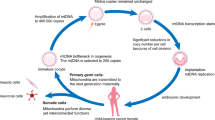Abstract
The regulation of protein turnover by the unique deubiquitinating enzyme ubiquitin C-terminal hydrolase L1 (UCHL1) is only seen in oocytes, spermatogonia, and neurons. Our objective was to investigate variation in expression of UCHL1 across fetal maturation of oocytes that result in lifelong ovarian reserve. We performed a retrospective cohort study of 25 fetal autopsy specimens from 21 to 36 weeks. This was an IRB-approved protocol with parental permission for use of tissues for research purposes. Tissues were stained for expression of the oocyte-specific protein UCHL1, and expression levels were evaluated using quantitative immunofluorescence across gestational ages after correction for the area and background absorbance. Corrected total cell fluorescence (CTCF) for expression of UCHL1 within human oocytes was compared across fetal gestational ages and oocyte size. Trends were analyzed using a locally weighted scatterplot smoothing algorithm. Local expression of UCHL1 increases in oocytes across ovarian development reaching a plateau at 27 weeks with the maintenance of elevated levels through 36 weeks gestational age. This maturation trend is also evidenced by the increase in protein expression as oocyte area increases (r = 0.5530, p ≤ 0.001) with the largest rise occurring as oocytes are enveloped into primordial follicles. The increase in expression as oocytes transition from oogonia into oocytes in primordial follicles and beyond may be part of the preparation of both oocytes and the surrounding somatic cells for the long-term maintenance of the ovarian reserve.




Similar content being viewed by others
Code Availability
Not applicable.
References
Edson MA, Nagaraja AK, Matzuk MM. The mammalian ovary from genesis to revelation. Endocr Rev. 2009;30(6):624–712.
Eppig J. Oocyte control of ovarian follicular development and function in mammals. Reprod. 2001;122(6):829–38.
Matzuk MM, et al. Intercellular communication in the mammalian ovary: oocytes carry the conversation. Sci. 2002;296(5576):2178–80.
Yatsenko SA, Rajkovic A. Genet. of hum. female infertil. Biol Reprod. 2019;101(3):549–66.
Cedars MI. Biomarkers of ovarian reserve–do they predict somatic aging? Semin Reprod Med. 2013;31(6):443–51.
Ellederova Z, et al. Protein patterns of pig oocytes during in vitro maturation. Biol Reprod. 2004;71(5):1533–9.
Massicotte L, et al. Maternal housekeeping proteins translated during bovine oocyte maturation and early embryo development. Proteom. 2006;6(13):3811–20.
Woodman MF, Ozcan MCH, Gura MA, De La Cruz P, Gadson AK, Grive KJ. The requirement of ubiquitin C-terminal hydrolase L1 in mouse ovarian development and fertility. Biol Reprod. 2022;107(2):500–13. https://doi.org/10.1093/biolre/ioac086.
Wang Y-L, et al. Overexpression of ubiquitin carboxyl-terminal hydrolase L1 arrests spermatogenesis in transgenic mice. Mol Reprod Dev. 2006;73(1):40–9.
Camara ML, et al. Fluoxetine-induced androgenic failure impairs the seminiferous tubules integrity and increases ubiquitin carboxyl-terminal hydrolase L1 (UCHL1): possible androgenic control of UCHL1 in germ cell death? Biomed Pharmacother. 2019;109:1126–39.
Lintern-Moore S, et al. Follicular development in the infant human ovary. J Reprod Fertil. 1974;39(1):53–64.
Yaakov O, et al. Acute adnexal torsion: is immediate surgical intervention associated with a better outcome? Gynecol Obstet Invest. 2022;87(2):100–4.
Schneider CA, Rasband WS, Eliceiri KW. NIH Image to ImageJ: 25 years of image analysis. Nat Methods. 2012;9(7):671–5. https://doi.org/10.1038/nmeth.2089.
Hammond L. Measuring cell fluorescence using ImageJ. 2014 [cited 2021; Available from: p. 5d853e60. https://theolb.readthedocs.io/en/latest/imaging/measuring-cell-fluorescence-using-imagej.html.
Telfer EE, McLaughlin M. In vitro development of ovarian follicles. Semin Reprod Med. 2011;29(1):15–23.
Wang J, et al. ACT and UCH-L1 polymorphisms in Parkinson’s disease and age of onset. Mov Disord. 2002;17(4):767–71.
Saini P, et al. Association study of DNAJC13, UCHL1, HTRA2, GIGYF2, and EIF4G1 with Parkinson’s disease. Neurobiol Aging. 2021;100:119.e7-119.e13.
Osier ND, et al. Variation in candidate traumatic brain injury biomarker genes are associated with gross neurological outcomes after severe traumatic brain injury. J Neurotrauma. 2018;35(22):2684–90.
Acknowledgements
We would like to acknowledge all the individual families that suffered the grief of losing a child. We thank them for their gift to science and the opportunity to study this critical period in ovarian development.
Funding
This work was supported by the North American Society for Pediatric and Adolescent Gynecology through the 2020 Fellow Research Grant.
Author information
Authors and Affiliations
Corresponding author
Ethics declarations
Ethics Approval
This study was reviewed by the Care New England-Women & Infants IRB.
Consent to Participate
The research was determined to be a research not involving human subjects as all tissue was collected under clinical consent with use for later research; 45 CFR 46 does not apply.
Consent for Publication
Not applicable.
Conflict of Interest
The authors declare no conflict of interest.
Additional information
Publisher's Note
Springer Nature remains neutral with regard to jurisdictional claims in published maps and institutional affiliations.
Rights and permissions
About this article
Cite this article
Ozcan, M.C.H., Cruz, L., Woodman, M.F. et al. Fetal Ovarian Reserve: the Dynamic Changes in Ubiquitin C-Terminal Hydrolase L1. Reprod. Sci. 30, 3353–3358 (2023). https://doi.org/10.1007/s43032-023-01275-z
Received:
Accepted:
Published:
Issue Date:
DOI: https://doi.org/10.1007/s43032-023-01275-z




